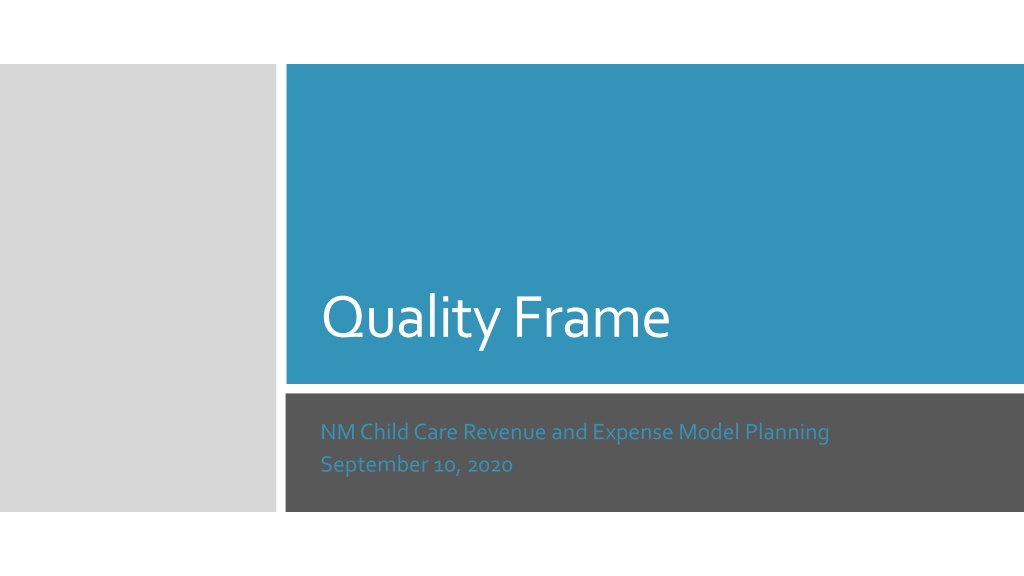
Child Care Revenue and Expense Model Planning Insights
Explore insights on child care revenue, expense modeling, staff qualifications, ratios, group sizes, and quality scenarios for various age groups and settings. Understand the factors affecting quality levels and cost drivers in child care services.
Download Presentation

Please find below an Image/Link to download the presentation.
The content on the website is provided AS IS for your information and personal use only. It may not be sold, licensed, or shared on other websites without obtaining consent from the author. Download presentation by click this link. If you encounter any issues during the download, it is possible that the publisher has removed the file from their server.
E N D
Presentation Transcript
Quality Frame NM Child Care Revenue and Expense Model Planning September 10, 2020
Ratios:Reduced ratios for all, or for younger age children Variances at Levels of Quality Staff qualifications: Increasing qualifications and compensation by level Time: Staff time for activities beyond what regulations require 2
Full day, full year child care Home based/family child care settings Center-based settings School settings Preschool settings (state funded) Model Options Regional selection Level of quality Star 2 Star 2+ or 3 Star 4 Star 5 3
Ratios Group Size Cost Variables of a Quality Frame Staff Qualifications Teacher Compensation Professional Development Non-classroom hours for teachers 4
Ratios and group sizes Coverage to staff to complete required training Time for child observations, family conferences, lesson planning Child screenings Continuous quality improvement New Mexico FOCUS Cost Drivers 5
Licensed Center 2+ or 3 Star 2 Star 4 star 5 star 1:6 12 1:6 12 1:5 10 1:4 8 Infant Quality Scenarios: Ratio & Group Size 1:10 20 1:10 20 1:8 16 1:6 12 2 years 1:12 24 1:12 24 1:10 20 1:9 18 3 years 1:12 24 1:12 24 1:10 20 1:10 20 4 years 1:15 30 1:15 25 1:12 24 1:10 20 5 years and up 6
2+ or 3 Star 2 Star 4 Star 5 Star 2years' experience + Professional PrepProgram Or 1 year experience + BAin ECE or related Successfully complete Child Growth Development and Learning course (3 credits) Successfully complete Assessment of Children and Evaluation of Programs (3 credits) Successfully complete Family and Community Collaboration, Health Safety and Nutrition or Guiding Young Children courses (5-6 credits) Site Director/ Education Coordinator Quality Scenarios: Staff Qualifications Take steps to complete NM Child Development Certificate or equivalent Annual PD Plan NM Child Development Certificate Successfully complete Child Growth Development and Learning course (3 credits) Successfully complete Assessment of Children and Evaluation of Programs (3 credits) Educator Annual PD Plan 7
Statewide Current Salaries (BLS) Kindergarten Parity Lead Teacher $33,160 $52,290 Assistant Teacher $23,470 $37,010 Floater/Teacher Aide $18,720 $31,200 Program Director $50,940 $84,220 Asst. Director, or equivalent $40,752 $67,376 Compensation Administrative Assistant $18,720 $25,630 Discussion Questions What salary levels should be included at each of the quality levels? Should salaries vary by geographic location? Should salaries vary by program size? Note: Asst Director is 80% of director salary. Floater/Aide is at minimum wage in current salaries, and $15/hour in kindergarten parity scenario 8
2 Star 2+ or 3 Star 4 Star 5 Star 3 within 45 days and every 4 months; 3 within 45 days and every 4 months; 4 within 45 days and every 4 months; 5 within 45 days and every 4 months Must use objective language Must use objective language and match domains and components Must use objective language and match domains and components and include contextual detail Child Observation Additional Quality Cost Drivers Use information from multiple sources Portfolio documentation for 2 EIs Complete NM quick look recording sheets, record data on 8 essential indicators; within 45 days and every 6 months Complete NM quick look recording sheets, and record data on 11 essential indicators; within 45 days and every 6 months Complete NM quick look recording sheets, record data on 14 essential indicators; within 45 days and every 6 months Preschoolers: Child assessment 9
5 Star 2 Star 2+ or 3 Star 4 Star Well-child visit within 2 months Developmental screening within 4 months; results shared with family Dental, vision hearing screenings within 6 months Health Promotion and Development Screenings Conference at end of school year Formally reflect on classroom practice weekly Conference 3 times per year Additional Quality Cost Drivers Family engagement Incorporate reflections into lessons plans to document planned changes. Reflective practice At least 2 hours per week For children with IFSP or IEP, actively participate Planning time 10
